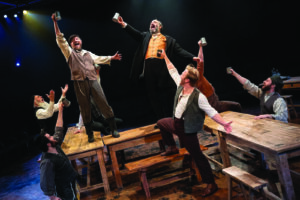I have a friend who said she read Madeleine L’Engle’s sci-fi novel, “A Wrinkle in Time,” as a book-wormish 10-year-old when it was published in 1961 and claims it was her favorite and changed her life.
Most people have heard of it one way or another, including as the result of its 2018 movie version with Oprah Winfrey and Reese Witherspoon, though that version was somewhat altered from the book, as my friend noted much to her chagrin. It’s also had a TV movie rendering. It is aimed at a teenage audience, but of course, it is universal and the music and pace truly rock.
Now comes a new version, again slightly altered but that is easily overlooked when compared to the energy, enthusiasm, colorful sets and costumes and sheer acting and singing talents of the cast.
It’s at D.C.’s Arena Stage through the middle of July and I have only three words to say about it, “Go see it!”
The story line is set in the context of new astrophysical evidence coming out of quantum physics suppositions that accounts for its title. In its book form it preceded, of course, “Star Trek” and “Star Wars.”
It is about two kids and a friend searching through the universe for their missing father. They have assistance from what may be surmised to be colorful, friendly aliens and have to overcome a powerful force of evil, called IT, that has imprisoned the dad for his refusal to conform with IT’s wishes in a transparent column in the Central Intelligence Building on the distant planet Camazotz.
Our three heroes, with the aid of some helpful alien tips, travel via a “tesseract” (a shortcut through space and time achieved by folding spacetime) to find and liberate the dad, but not without encountering and struggling against temptations thrown in their way by the disemboweled mind of IT, a powerful and malevolent disembodied brain that controls the minds and thoughts of all the planet’s inhabitants.
Importantly for younger audiences, the book/movie/musical takes issue with indifference or cynicism, suggesting that all things that matter in life come from striving. At one key juncture, when the daughter Meg (played by Taylor Iman Jones, the star of the show), goes head to head with the evil IT, one of her otherworldly advisers suggests that she’s got a weapon that IT doesn’t, and Meg undertakes to figure out what that is in order to use it. (No spoiler here, you’ll have to see the show to find out!)
The original novel at the time was controversial and banned in some quarters for, essentially, mixing religion, science and the supernatural, according to the Carnegie-Mellon University’s Banned Books Project.
For example, a person in Alabama wanted it banned because In 1990, a parent at Tenth Street Elementary School in Anniston, Alabama requested the book be removed because it “sends a mixed signal to children about good and evil” and “[lists] the name of Jesus Christ together with the names of great artists, philosophers, scientists, and religious leaders when referring to defenders of Earth against evil.”
But it has been widely defended, including by a professor of literacy education at the University of Minnesota, Marek Oziewicz who said the author “was engaged in this project of revisioning Christianity, pretty much like C.S. Lewis was with The Chronicles of Narnia. It was “a vision of Christianity as a form of science, and science as a form of search for spirituality.”
The author herself, L’Engle, said of it, “There’s overlap between science and spirituality, and that new Christianity would be fully compatible with what modern science tells us about the universe.”
It was the first of five books expanding on a similar story line, the others being “A Wind in the Door,” A Swiftly Tilting Planet, “Many Waters,” and “An Acceptable Time.”
The Arena Stage is the musical’s first stop, surely on its way to Broadway. I have a friend who said she read Madeleine L’Engle’s sci-fi novel, “A Wrinkle in Time,” as a book-wormish 10-year-old when it was published in 1961 and claims it was her favorite and changed her life.
Most people have heard of it one way or another, including as the result of its 2018 movie version with Oprah Winfrey and Reese Witherspoon, though that version was somewhat altered from the book, as my friend noted much to her chagrin. It’s also had a TV movie rendering. It is aimed at a teenage audience, but of course, it is universal and the music and pace truly rock.
Now comes a new version, again slightly altered but that is easily overlooked when compared to the energy, enthusiasm, colorful sets and costumes and sheer acting and singing talents of the cast.
It’s at D.C.’s Arena Stage through the middle of July and I have only three words to say about it, “Go see it!”
The story line is set in the context of new astrophysical evidence coming out of quantum physics suppositions that accounts for its title. In its book form it preceded, of course, “Star Trek” and “Star Wars.”
It is about two kids and a friend searching through the universe for their missing father. They have assistance from what may be surmised to be colorful, friendly aliens and have to overcome a powerful force of evil, called IT, that has imprisoned the dad for his refusal to conform with IT’s wishes in a transparent column in the Central Intelligence Building on the distant planet Camazotz.
Our three heroes, with the aid of some helpful alien tips, travel via a “tesseract” (a shortcut through space and time achieved by folding spacetime) to find and liberate the dad, but not without encountering and struggling against temptations thrown in their way by the disemboweled mind of IT, a powerful and malevolent disembodied brain that controls the minds and thoughts of all the planet’s inhabitants.
Importantly for younger audiences, the book/movie/musical takes issue with indifference or cynicism, suggesting that all things that matter in life come from striving. At one key juncture, when the daughter Meg (played by Taylor Iman Jones, the star of the show), goes head to head with the evil IT, one of her otherworldly advisers suggests that she’s got a weapon that IT doesn’t, and Meg undertakes to figure out what that is in order to use it. (No spoiler here, you’ll have to see the show to find out!)
The original novel at the time was controversial and banned in some quarters for, essentially, mixing religion, science and the supernatural, according to the Carnegie-Mellon University’s Banned Books Project.
For example, a person in Alabama wanted it banned because In 1990, a parent at Tenth Street Elementary School in Anniston, Alabama requested the book be removed because it “sends a mixed signal to children about good and evil” and “[lists] the name of Jesus Christ together with the names of great artists, philosophers, scientists, and religious leaders when referring to defenders of Earth against evil.”
But it has been widely defended, including by a professor of literacy education at the University of Minnesota, Marek Oziewicz who said the author “was engaged in this project of revisioning Christianity, pretty much like C.S. Lewis was with The Chronicles of Narnia. It was “a vision of Christianity as a form of science, and science as a form of search for spirituality.”
The author herself, L’Engle, said of it, “There’s overlap between science and spirituality, and that new Christianity would be fully compatible with what modern science tells us about the universe.”
It was the first of five books expanding on a similar story line, the others being “A Wind in the Door,” A Swiftly Tilting Planet, “Many Waters,” and “An Acceptable Time.”
The Arena Stage is the musical’s first stop, surely on its way to Broadway.













